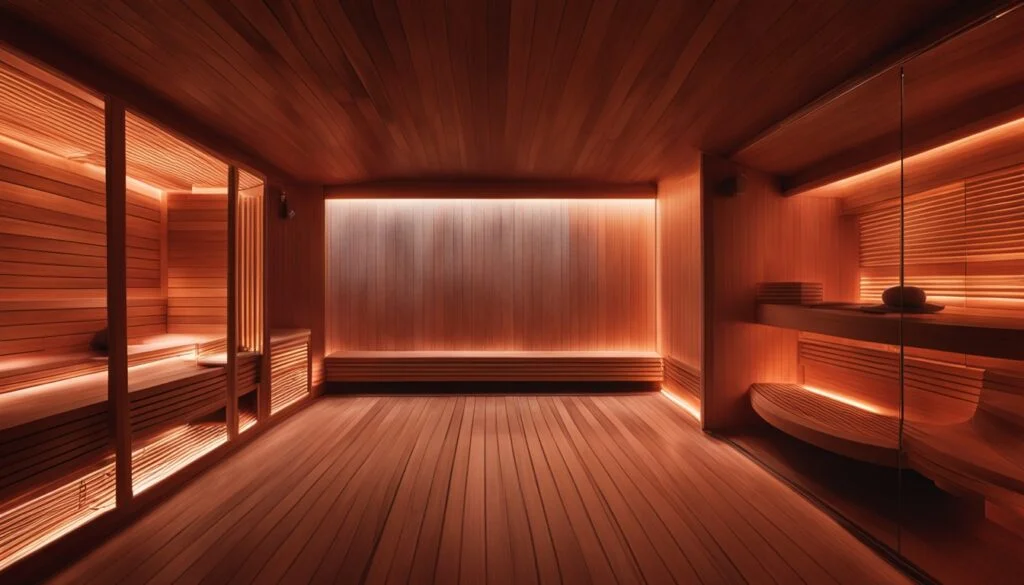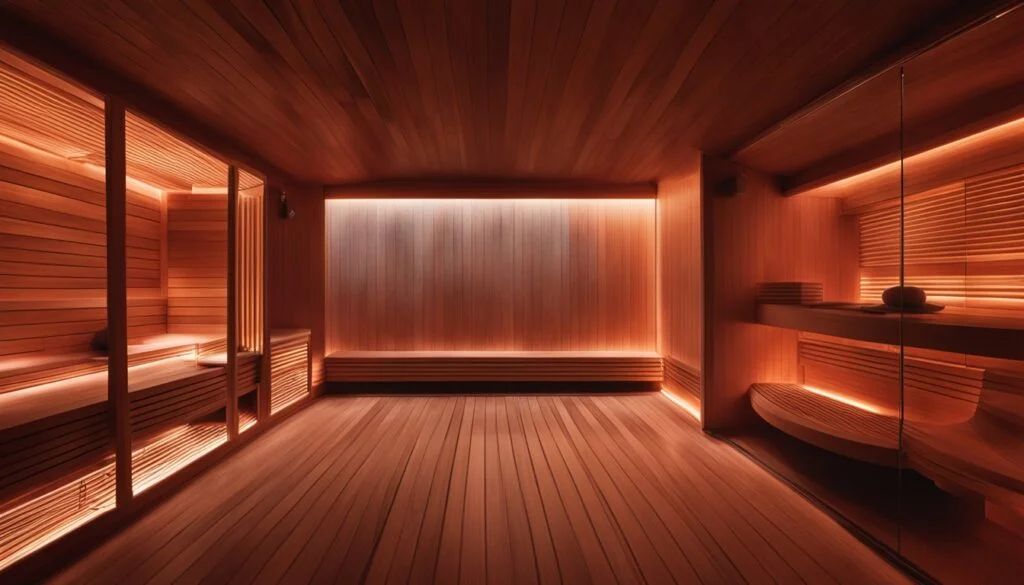I’ve been looking into wellness practices and found a big debate. It’s between infrared saunas and steam rooms. Both offer special heat therapy. But which one is best for you? Let’s look at infrared sauna vs steam and see what each offers.
Infrared saunas warm your body with light waves. They work at a cozy 115-130°F. Steam rooms, on the other hand, create a moist place at about 120°F. They can get as humid as 100%. Both promise to relax you and have health benefits, but they do it in different ways.

I’ve tried both, and they feel very different. In an infrared sauna, I feel the heat go deep into my muscles. A steam room wraps me in a warm cloud. It’s like feeling dry desert heat versus tropical rainforest warmth. Both are hot, but they give off different feelings.
Key Takeaways
- Infrared saunas operate at lower temperatures than traditional saunas
- Steam rooms offer high humidity levels, beneficial for respiratory health
- Infrared heat penetrates deeper into the body than steam
- Both options provide stress relief, relaxation and skin benefits
- Choosing between the two depends on personal health goals
- Proper hydration is crucial for both infrared sauna and steam room sessions
Understanding the Basics of Heat Therapy
Heat therapy, or thermotherapy, has been around for centuries. It’s amazing how heat can help our bodies. Let’s look at heat therapy’s history and its great benefits.
What is thermotherapy?
Thermotherapy uses heat to help us heal and relax. It’s a natural way to make our bodies better. You can use things like hot water bottles or modern infrared saunas. The goal is to warm up parts of the body to make us feel good.
The history of saunas and steam rooms
Saunas and steam rooms have a long history. Many cultures, like the Romans and Native Americans, used them for health and spiritual reasons. The Finnish sauna tradition is over 2,000 years old and is known for its health benefits.

How heat affects the human body
Heat therapy is great for our bodies. It makes blood flow better, bringing oxygen and nutrients to our muscles. This can help with muscle pain and tension. Sweating out toxins makes our skin look healthy.
Heat also makes our body release happy chemicals called endorphins.
| Heat Therapy Type | Temperature Range | Benefits |
|---|---|---|
| Infrared Sauna | 46-57°C (115-135°F) | Improved circulation, pain relief, skin health |
| Steam Room | 30-50°C (86-122°F) | Respiratory health, skin hydration, relaxation |
Whether you like infrared saunas or steam rooms, heat therapy is good for you. It helps with detox, stress, and overall health.
Infrared Sauna: Technology and Mechanisms
Infrared saunas have changed the way we think about heat therapy. They use light to make heat. This gives us a new way to relax and stay healthy.
How infrared rays work
Infrared rays are not seen by the human eye. In infrared saunas, these rays go deep into the body. They heat it from the inside out.
This method is better than old-style saunas. It can reach deep into the body. This helps with blood flow and can ease pain.

Types of infrared saunas
There are three main kinds of infrared saunas. Each uses a different kind of infrared light:
- Near-infrared: Good for skin health and making collagen
- Mid-infrared: Helps with muscle recovery and eases pain
- Far infrared: Goes deepest, helps with detox and heart health
Temperature range and humidity levels
Infrared saunas are cooler than old-style saunas, from 100°F to 140°F. They also have lower humidity. This makes them more comfortable for many people.
This lets people stay in them longer. And they might get more health benefits.
| Feature | Infrared Sauna | Traditional Sauna |
|---|---|---|
| Temperature Range | 100°F – 140°F | 150°F – 195°F |
| Humidity Level | Low | High |
| Heat Penetration | Deep (several cm) | Superficial |
| Energy Efficiency | High | Moderate |
Steam Room: Structure and Function
Steam rooms use moist heat therapy. They are simple yet effective. Made of non-porous materials like glass or tile, they’re perfect for steam.
A steam generator is at the heart of a steam room. It sends in hot, moist air. This makes the humidity almost 100% and the temperature around 120°F.
Steam rooms are different from dry saunas because of their high humidity. This makes breathing easier and can help with breathing problems. It’s like a warm hug for your lungs!
Steam rooms are great for your skin too. The moisture opens up pores for a deep cleanse. I feel like I’ve had a mini-facial after using one.
“Stepping into a steam room is like entering a cloud of warmth and relaxation. It’s an experience that engages all your senses.”
Here’s what happens in a steam room:
- Steam fills the room, creating a misty atmosphere
- Your body temperature rises gradually
- Sweat glands open, helping to flush out toxins
- Blood vessels dilate, improving circulation
- Muscles relax, easing tension and soreness
Remember, steam rooms have many benefits but you should stay hydrated. Limit your time to 15-20 minutes. Listen to your body and enjoy the steam!
Infrared Sauna vs Steam: Key Differences
When we look at infrared vs steam saunas, we see big differences. These differences are key in the sauna comparison and how we feel the heat.
Heat Source and Penetration
Infrared saunas heat in a special way. They send infrared rays deep into your body. This makes you warm from the inside out. The temperature is lower, between 100-140°F.
Steam rooms heat the air around you. They work at higher temperatures, from 150-190°F.
Humidity Levels and Comfort
Humidity levels are quite different between the two. Steam rooms are full of moist heat. They make the air humid by heating water to 110-120°F.
Infrared saunas give a dry heat with little humidity.
Energy Efficiency and Operating Costs
Infrared saunas use less energy. They heat up quickly, in 15-20 minutes. Steam rooms take 30-40 minutes to warm up.
This quick heating means infrared saunas cost less to run over time.
| Feature | Infrared Sauna | Steam Room |
|---|---|---|
| Temperature Range | 100-140°F | 150-190°F |
| Humidity | Low | High |
| Heat-up Time | 15-20 minutes | 30-40 minutes |
| Heat Penetration | Deep (body core) | Surface level |
| Energy Efficiency | Higher | Lower |
Health Benefits of Infrared Saunas
I’ve looked into infrared sauna benefits and found some cool stuff. These saunas use special light to heat your body. This brings many health benefits.
Detoxification and Weight Loss
Infrared saunas help with detoxification. The heat makes you sweat out toxins. They can even detox at a cellular level.
They’re not a magic way to lose weight, but they can help. A study found some fat loss in regular sauna users.
Pain Relief and Muscle Recovery
If you have aches and pains, infrared saunas might be good for you. They help with conditions like arthritis and fibromyalgia. The heat also helps with muscle recovery after exercise.
Cardiovascular Health Improvements
Infrared saunas are great for your heart. They can help control blood pressure and lower heart risks. In Japan and Korea, doctors use them to treat heart issues.
This therapy is called “Waon therapy.” It helps people with chronic heart failure.
| Benefit | Description |
|---|---|
| Detoxification | Deep penetration leads to cellular detox |
| Weight Loss | Potential fat loss with regular use |
| Pain Relief | Eases symptoms of arthritis and fibromyalgia |
| Heart Health | Regulates blood pressure, reduces heart risks |
These benefits are great, but remember to stay hydrated and use saunas safely. Always talk to your doctor before trying new health routines.
Therapeutic Advantages of Steam Rooms
Steam rooms are great for your health. They are warm and very humid, making you feel good. They help with many health issues.
They are good for your lungs. The warm air clears out sinuses and helps with congestion. This is great for people with breathing problems. The steam also makes your skin healthy and can help with acne.
Studies from Harvard Medical School say steam rooms improve blood flow. This is good for your muscles and joints. It helps with soreness and pain.
- Clears sinuses and relieves congestion
- Improves skin hydration
- Boosts circulation
- Reduces muscle soreness and joint pain
- Promotes relaxation and stress relief
Steam rooms are great for joint pain and skin problems. They also help with inflammation and lower blood pressure. But, don’t stay in one for more than 15 minutes to avoid dehydration.
Steam rooms and saunas both have health benefits. But steam rooms might be better for easing muscle soreness. The steam makes you feel very relaxed. It’s perfect for stress relief and chilling out.
Comparing the User Experience
I’ve tried both infrared saunas and steam rooms. Each one gives a unique sauna experience. Let’s look at the comfort, how long you can stay, and what happens after.
Comfort and Relaxation Factors
Infrared saunas have a dry, gentle heat that goes deep into your body. I like the temperature of 120°F-150°F for longer times. Steam rooms are different, with moist heat and a temperature of 100°F-120°F. The high humidity makes you sweat a lot, but it’s good for your skin.
Duration of Sessions
I can relax in an infrared sauna for 30-45 minutes. The dry heat lets me stay longer. Steam rooms are shorter, about 10-20 minutes, because of the high humidity. Always listen to your body and drink water in both.
Post-session Feelings and Effects
After an infrared sauna, I feel very relaxed and full of energy. My muscles are relaxed, and I sleep better. Steam rooms make me feel fresh and clean, helping my skin and lungs.
| Factor | Infrared Sauna | Steam Room |
|---|---|---|
| Temperature Range | 120°F-150°F | 100°F-120°F |
| Humidity | Low | High |
| Typical Session Duration | 30-45 minutes | 10-20 minutes |
| Key Benefits | Deep relaxation, muscle recovery | Skin cleansing, respiratory benefits |
Both infrared saunas and steam rooms have their own benefits. What you like may depend on what you want for your health. Trying both can help you find the best heat therapy for you.
Installation and Maintenance Considerations
Home saunas need the right setup and upkeep. I’ve looked into infrared and steam options for you.
Space Requirements and Setup Process
Infrared saunas fit easily in most homes. They’re small and don’t need special plumbing. You can set them up by yourself and use a regular outlet.
Steam rooms need more room and complex systems for air and water. They usually need a pro to install them, which can cost more.
Ongoing Care and Cleaning Needs
Looking after your sauna is important. Infrared saunas are easy to keep clean with just a wipe now and then.
Steam rooms need more work because they get wet. You must clean them often to stop mold and bacteria. This affects how much you’ll enjoy your sauna over time.
Longevity and Durability Comparison
Infrared saunas last longer and need less upkeep. Their heaters don’t break down as fast. Steam rooms have parts that might need fixing or replacing, which can shorten their life and increase costs.
| Feature | Infrared Sauna | Steam Room |
|---|---|---|
| Installation Ease | High | Low |
| Space Required | Minimal | Substantial |
| Maintenance Level | Low | High |
| Durability | High | Moderate |
Choosing between infrared and steam saunas depends on your space, budget, and upkeep willingness. Both have great benefits. But knowing these differences will help you choose the best for your home sauna.
Conclusion
I looked into infrared sauna vs steam room. Both have their own health benefits. Infrared saunas use dry heat and cost less, from $2,000 to $10,000. They also need less upkeep.
Steam rooms get hotter, between 160°F to 200°F, and are very humid. They’re great for making collagen and sweating a lot. Infrared saunas heat up fast, in 10 to 15 minutes, which is good for busy people.
Steam rooms take longer to warm up but offer a special kind of calm. Both can be good for your health, depending on what you want. Choosing between them depends on your personal needs.
Whether you want to detox, recover from exercise, or just relax, both options are good. Adding either or both to your routine could help you feel better and more relaxed.
FAQ
What is the main difference between infrared saunas and steam rooms?
Infrared saunas use light waves to heat the body in a dry place. Steam rooms make a lot of steam for moist heat.
How does heat therapy benefit the body?
Heat therapy has been around for a long time to help with health. It makes blood flow better, helps you sweat, and relaxes muscles. This can improve circulation, detox, and make you feel relaxed.
What are the different types of infrared radiation used in saunas?
There are three kinds of infrared used in saunas: near, mid, and far infrared. Far infrared goes deepest and is often used in saunas.
Are infrared saunas more energy-efficient than steam rooms?
Yes, infrared saunas use less energy and cost less to run than steam rooms. Steam rooms need more energy for the high humidity.
What are the potential health benefits of using infrared saunas?
Infrared saunas can help detox through sweating and might help you lose weight. They can ease pain, help muscles recover, improve heart health, and help you sleep better.
How can steam rooms benefit respiratory health?
Steam rooms can clear sinuses, ease congestion, and help with breathing problems. They’re good for people with respiratory issues or allergies.
Which type of heat therapy is more comfortable for longer sessions?
Infrared saunas are better for longer sessions because they’re not as hot and dry. Steam room sessions are shorter because of the high humidity.
Are infrared saunas easier to install and maintain than steam rooms?
Yes, infrared saunas are easier to set up and keep up. They don’t need much space and are simpler to install. Steam rooms are harder to set up because they need good ventilation and drainage.








1 thought on “Infrared Sauna vs Steam: Which Is Best for You?”
Comments are closed.